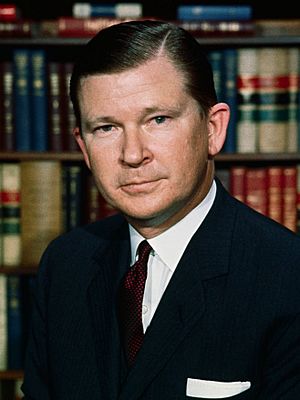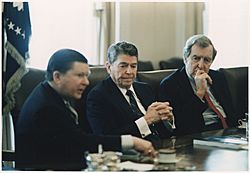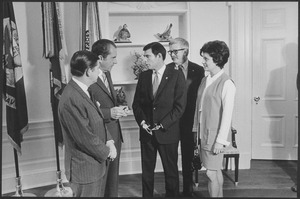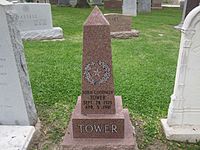John Tower facts for kids
Quick facts for kids
John Tower
|
|
|---|---|

Tower in 1966
|
|
| Chair of the President's Intelligence Advisory Board | |
| In office July 17, 1990 – April 5, 1991 |
|
| President | George H. W. Bush |
| Preceded by | Anne Armstrong |
| Succeeded by | Bobby Inman (acting) |
| Chair of the Senate Armed Services Committee | |
| In office January 3, 1981 – January 3, 1985 |
|
| Preceded by | John Stennis |
| Succeeded by | Barry Goldwater |
| United States Senator from Texas |
|
| In office June 15, 1961 – January 3, 1985 |
|
| Preceded by | Bill Blakley |
| Succeeded by | Phil Gramm |
| Personal details | |
| Born |
John Goodwin Tower
September 29, 1925 Houston, Texas, U.S. |
| Died | April 5, 1991 (aged 65) Brunswick, Georgia, U.S. |
| Political party | Republican (1951–1991) |
| Other political affiliations |
Democratic (before 1951) |
| Spouses |
Joza Bullington
(m. 1952; div. 1976)Lilla Cummings
(m. 1977; div. 1987) |
| Children | 3 |
| Education | Southwestern University (BA) Southern Methodist University (MA) London School of Economics |
| Military service | |
| Allegiance | |
| Branch/service | |
| Years of service | 1943–1946 (Active) 1946-1989 (Reserve) |
| Rank | |
| Unit | U.S. Naval Reserve |
| Battles/wars | |
John Goodwin Tower (born September 29, 1925 – died April 5, 1991) was an American politician and military officer. He represented the state of Texas in the United States Senate for many years, from 1961 to 1985. He was a member of the Republican Party.
John Tower was the first Republican to be elected to the U.S. Senate from Texas since the time after the American Civil War, known as Reconstruction. He is also well-known for leading the Tower Commission. This group investigated an important event called the Iran-Contra Affair during Ronald Reagan's time as president.
Born in Houston, Texas, Tower served in the United States Navy during World War II. After the war, he worked as a radio announcer and taught at Midwestern University. He later became a Republican and worked on Dwight D. Eisenhower's presidential campaign in 1956.
In 1960, he ran for Senate against Lyndon B. Johnson but lost. However, when Johnson became Vice President, his Senate seat became open. In a special election in 1961, Tower won, becoming a U.S. Senator. He was re-elected three more times. After leaving the Senate, he continued to serve the country, including leading the Tower Commission. He passed away in a plane crash in 1991.
Contents
Early Life, Education, and Military Service
John Tower was born in Houston, Texas. His parents were Joe Z. Tower and Beryl Goodwin Tower. His family moved often because his father was a Methodist minister.
He went to public schools in Houston and Beaumont, Texas, graduating from Beaumont High School in 1942. After high school, he started college at Southwestern University.
In June 1943, Tower paused his studies to join the United States Navy. He served during the Pacific Theater of World War II on an amphibious gunboat. In March 1946, he was discharged from the Navy and went back to Southwestern University. He earned his Bachelor of Arts degree in political science in 1948.
While in college, Tower worked as a radio announcer for a country music station. He continued his military service in the United States Naval Reserve until 1989, reaching the rank of master chief's boatswain mate.
In 1949, he began studying political science at Southern Methodist University. He also worked part-time as an insurance agent. From 1951 to 1960, Tower was an assistant professor of political science at Midwestern University. He also studied at the London School of Economics in 1952 and 1953. He earned his Master of Arts degree from Southern Methodist University in 1953.
Early Political Career
John Tower grew up in a family that supported the Democratic Party. However, he became a Republican around 1951 while in college. He quickly became important in the Texas Republican Party.
In 1954, he ran for the Texas House of Representatives but did not win. He was a delegate to the 1956 Republican National Convention. In the 1956 presidential election, he managed Dwight D. Eisenhower's campaign in his local area.
1960 Senate Election
In 1960, the Republican Party in Texas chose John Tower to run for the United States Senate. He ran against Lyndon B. Johnson, who was already a well-known Senator.
Johnson was also running to become Vice President of the United States with John F. Kennedy. Tower's campaign slogan was "double your pleasure, double your fun — vote against Johnson two times, not one." Johnson won the election.
1961 Senate Election
After Lyndon Johnson became Vice President, his Senate seat became empty. A special election was held to choose who would fill the seat.
John Tower ran again. He received the most votes in the first round. In the final election, he won against William A. Blakley, who had been temporarily appointed to the Senate seat. Tower won with 50.6% of the votes. This made him the first Republican elected to the Senate from Texas since the Reconstruction period.
United States Senate
When John Tower joined the Senate in 1961, he was assigned to two important committees. These were the Labor and Public Welfare Committee and the Committee on Banking, Housing, and Urban Affairs.
In 1965, he joined the Senate Armed Services Committee. He served on this committee until he retired. From 1981 to 1984, he was the chairman of the Armed Services Committee. As a member and later chairman, Tower strongly supported making the military modern and strong.
On the Banking and Currency Committee, he worked to help small businesses. He also worked to improve the country's infrastructure and financial systems. Tower supported Texas's economy, especially the energy, farming, and fishing industries.
Civil Rights
John Tower voted against the Civil Rights Act of 1964 and the Voting Rights Act of 1965. He also voted against the 24th Amendment to the U.S. Constitution. However, he did vote to confirm Thurgood Marshall to the U.S. Supreme Court.
Even though he opposed the final Civil Rights Act of 1964, Tower also voted against an amendment that would have made the law weaker. He explained his vote by saying that if people in states and cities accept federal money, they should not be allowed to discriminate.
Post-Senate Career

John Tower retired from the Senate after nearly 24 years. He continued to be involved in national politics. He advised the campaigns of Ronald Reagan and George H. W. Bush.
Two weeks after leaving office, Tower became the chief U.S. negotiator for the Strategic Arms Reduction Talks in Geneva, Switzerland. He left this job in 1987 and became a professor at Southern Methodist University for a time.
In November 1986, President Reagan asked Tower to lead a special group called the President's Special Review Board. This group was created to study the actions of the National Security Council during the Iran–Contra affair. The group became known as the Tower Commission. Its report, released in February 1987, was critical of how the Reagan administration handled relations with Iran and the Nicaraguan Contras.
In 1989, President George H. W. Bush chose Tower to be his Secretary of Defense. However, the Senate rejected his nomination. This was unusual, especially since Tower had been a Senator himself. The Senate voted 47–53 against him. This was the first time the Senate had rejected a new president's choice for a Cabinet position.
After this, Tower was named chairman of the President's Foreign Intelligence Advisory Board. Dick Cheney later became Secretary of Defense instead.
Personal Life
While teaching at Midwestern State University, John Tower met Joza Lou Bullington. They married in 1952. John and Lou Tower had three daughters: Penny (born 1954), Marian (born 1955), and Jeanne (born 1956). They divorced in 1976.
After his divorce from Lou, Tower married Lilla Burt Cummings in 1977. They separated in 1985 and divorced in 1986.
Death and Legacy
On April 5, 1991, John Tower was on Atlantic Southeast Airlines Flight 2311. The plane crashed while trying to land in Brunswick, Georgia. Everyone on board died instantly. This included Tower, his daughter Marian, and the astronaut Sonny Carter. An investigation found that the crash was caused by a problem with the plane's propeller control unit.
John Tower and his daughter Marian are buried together in the family plot at the Sparkman-Hillcrest Memorial Park Cemetery in Dallas. A cenotaph (a monument for someone buried elsewhere) in Tower's honor was placed at the Texas State Cemetery in Austin.
Tower wrote a book about his life and politics called Consequences: A Personal and Political Memoir. It was published a few months before he died. He gave his personal papers to his old college, Southwestern University.
See also
 In Spanish: John Tower para niños
In Spanish: John Tower para niños



